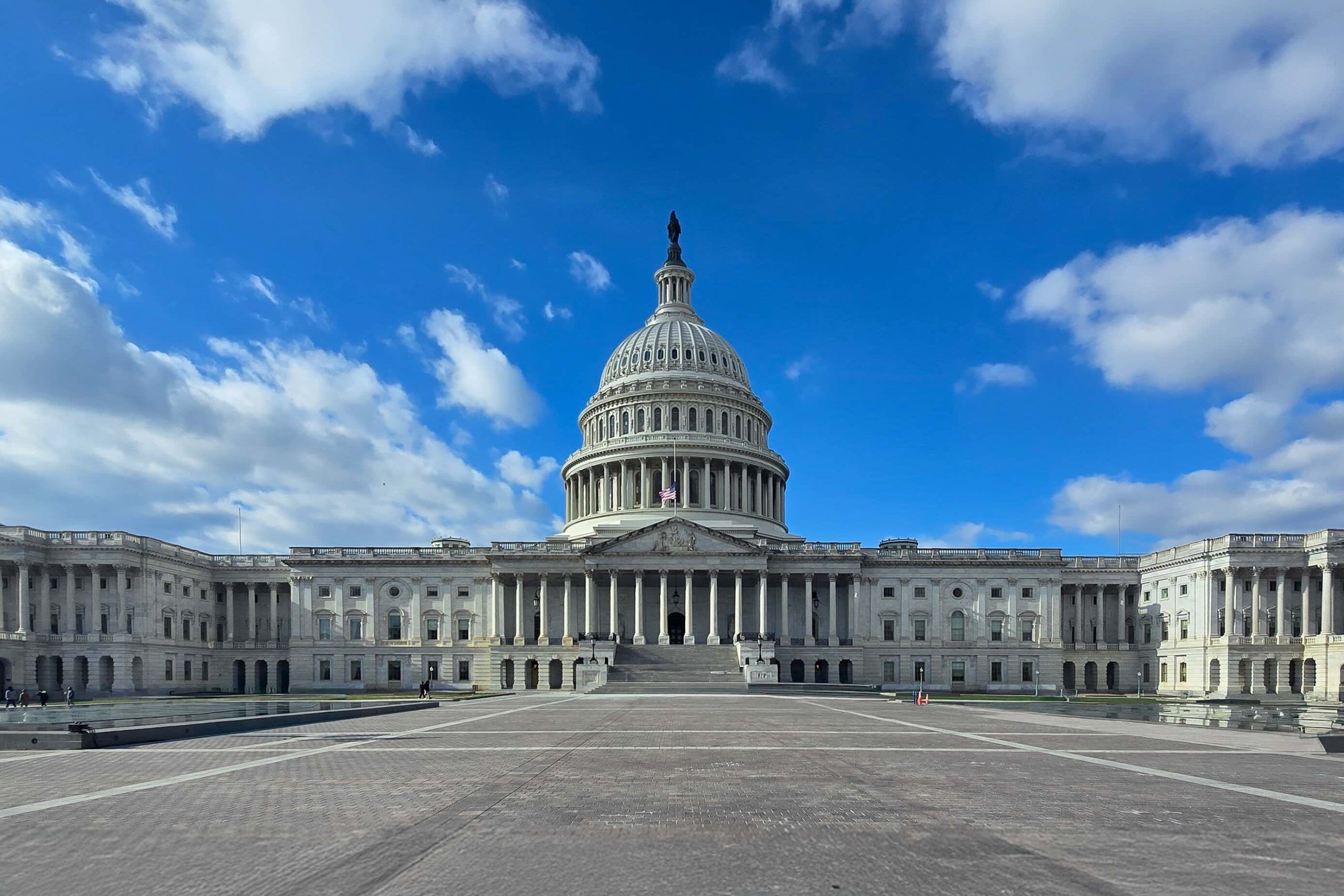- Congress failed to pass stopgap funding by the Sept. 30 deadline, triggering a federal government shutdown at 12:01 a.m. (ET) Oct. 1 – the first U.S. shutdown in nearly seven years [1] [2].
- All non-essential federal agencies have halted or curtailed operations: hundreds of thousands of civil servants are being furloughed or required to work without pay, while only “essential” functions (like national security, law enforcement, and air traffic control) continue (unpaid) [3] [4].
- The political impasse centered on health-care funding: Democrats demanded extensions of ACA subsidies and Medicaid protections as part of any funding bill, while Republicans insisted on a “clean” short-term funding measure. Both the GOP’s bill (to fund government through Nov. 21) and the Democrats’ proposal (shorter funding plus concessions) failed in the Senate [5] [6].
- Markets reacted calmly overnight: U.S. stock futures and the Bloomberg dollar index dipped modestly on the shutdown news [7] [8]. Historically investors have “shrugged off” such shutdowns, but analysts warn this time is different given the fragile economy and missing data [9] [10].
- Key economic data will be delayed. The Bureau of Labor Statistics (BLS) has suspended all operations during the lapse, meaning Friday’s September jobs report and future inflation releases (CPI, PPI) will not come out on schedule [11] [12]. Without that data, the Fed will be “flying blind” on growth and inflation [13].
- Economists warn that every extra week of shutdown costs roughly 0.1 percentage point of quarterly GDP (about $7 billion) [14] [15]. If prolonged, consumer confidence (already weak) could crumble: UMass economist Gerald Epstein says a long shutdown “almost certainly will be quite negative,” especially in a fragile economy [16].
- Politicians are blaming each other. Senate Democrats accuse Republicans (who control the White House and Congress) of causing the shutdown and risking millions’ health care [17] [18], while GOP leaders cast blame on Democrats for “voting to close the government” [19] [20]. President Trump has threatened mass layoffs of federal workers if the shutdown proceeds – explicitly saying he would fire “a lot of people… they’re going to be Democrats” [21] [22].
How the Shutdown Happened
As the Sept. 30 spending deadline loomed, Congress remained deadlocked. The Republican-led House had passed a “clean” Continuing Resolution to extend funding (through Nov. 21 at existing levels), but Senate Democrats refused to back it without adding policy changes, chiefly extensions of Affordable Care Act (ACA) insurance subsidies and undoing GOP Medicaid cuts [23] [24]. Senate Majority Leader John Thune tried (and failed) to invoke cloture on both the House GOP plan and a Democratic proposal that would fund through October with health-care add-ons. Neither measure secured the 60 votes needed, and the Senate adjourned without agreement. Once the clock struck midnight on Sept. 30, all unobligated appropriated funding lapsed, as The Washington Post and Reuters report [25] [26]. President Trump did meet with congressional leaders on Sept. 29, but talks collapsed. The White House Office of Management and Budget immediately directed agencies to execute their shutdown plans: “halt all but essential duties,” they ordered, “disrupting the jobs of hundreds of thousands of Americans” [27] [28].
Republicans insist they offered a fix and pin the blame on Democrats, who they say “voted to CLOSE the government.” House Speaker Mike Johnson issued a post-shutdown statement accusing Senate Democrats of “leav[ing] moms and kids…unpaid” (TSA agents, soldiers, etc.) [29]. Senate Minority Leader Chuck Schumer fired back that GOP-controlled Congress “is plunging America into a shutdown, rejecting bipartisan talks and risking America’s health care” by refusing to extend premium tax credits [30]. The partisan tit-for-tat suggests the shutdown could persist until one side yields.
Government Shutdown Mechanics: Furloughs and Services Halted
When funding ends, federal agencies must invoke the Antideficiency Act and halt all non-essential activities. By this morning, thousands of agencies were drawing down to skeleton crews. U.S. travel, trade and regulatory bodies will operate on shoestring staff: for example, the SEC will be reduced to about 9% of its workforce [31], and the CFTC will furlough nearly all employees [32]. Hundreds of federal contract services will be suspended. In practice, this means hundreds of thousands of federal civilian employees will be furloughed (sent home without work or pay) or in some cases told to work without pay if deemed “essential” to life or safety. In the 2018–19 shutdown, roughly 380,000 civil servants were furloughed and 420,000 worked unpaid [33]. This time a similarly large workforce is affected, though official tallies won’t be known until agencies file shutdown plans. All workers are promised retroactive back pay once Congress reopens the government, but “this does not prevent the immediate financial difficulties they face,” notes Rep. Ami Bera’s congressional FAQ [34].
Many public services are halted or delayed. Historical examples (2018–19 shutdown) include routine FDA inspections being suspended and national parks losing trash pickup and road repairs [35]. Over 86,000 immigration court hearings were cancelled and low-income programs like TANF were at risk [36]. During a shutdown, essential services continue but often under strain: inpatient military hospitals and emergency medical care stay open, as do air traffic controllers and border patrol [37]. (Notably, flight and security operations grind on, but with fewer controllers and TSA agents working; past shutdowns have caused major flight delays or even brief airspace halts). Social Security and Medicare benefits continue because they are on mandatory funding – though initial staff furloughs can delay processing. In Bera’s words, crucial functions “remain uninterrupted,” but non-appropriated services like postal mail keep running while routine claims processing (e.g. VA benefits, passport renewals, IRS audits) will slow to a crawl [38] [39]. A Bloomberg analysis adds that “agencies also issued detailed shutdown plans” closing most offices performing research, regulatory work or public assistance, sending “tens of thousands” home [40].
Economic and Market Effects
In the near term, economists say the shutdown’s direct economic hit is modest if brief. Economists Mark Zandi and Gregory Daco estimate each full week of shutdown lops off roughly 0.1 percentage point from quarterly GDP (about $7 billion lost per week) [41] [42]. EY’s chief economist Gregory Daco warns that “each week of shutdown could reduce Q4 GDP by 0.1 percentage points… largely due to lost wages, procurement delays and softer final demand” [43]. Federal Reserve Bank of Philadelphia’s Mark Zandi concurs that in stable times a short lapse is “not a particularly big deal,” but adds that now – with slowing growth and sticky inflation – it’s a bigger concern. UMass economist Gerald Epstein observes “if it’s a long shutdown, it almost certainly will be quite negative,” especially since consumer sentiment tends to dip during shutdowns [44]. (Indeed, data from Michigan sentiment surveys show each of the last three shutdowns chipped away at consumer confidence [45].)
The biggest immediate impact is lost paychecks and delayed services, which dampens consumer spending and hiring. A senior economist at Interactive Brokers, José Torres, notes that “an extended halt” would weigh on consumer spending and hiring decisions [46]. The Federal Reserve – already navigating high inflation and a still-tight labor market – will face greater uncertainty because key monthly data will be missing. The Labor Department’s contingency plan calls for suspending all BLS data collection during a shutdown [47]. In practice, this means Friday’s October jobs report won’t be released as scheduled, and crucial inflation reports (Consumer Price Index, Producer Price Index) for mid-October will be delayed [48] [49]. As Reuters explains, without September employment and price data, the Fed will be “flying blind” and likely hold to its September rate path (two more quarter-point cuts penciled in for 2025) [50]. In short, investors say the data blackout may force markets to rely on private indicators and make trading more tentative.
Markets so far have barely budged: stock index futures and the dollar fell only slightly last night [51]. A Reuters market survey notes that past shutdowns “have tended to exhibit muted reactions” in markets [52]. Indeed, Wall Street “shrugged” through previous stalemates – the S&P 500 actually rose during each of the last four shutdowns [53]. Traders now fear a possible spike in volatility if the shutdown drags on. For example, TD Securities warns that market momentum (the Treasury yield curve) could shift – with traders swiftly pricing in rate cuts if economic data vanishes [54]. Some regulations will pause: the SEC will furlough most staff (limiting its ability to review deals or filings), effectively freezing new IPOs and security approvals [55] [56]. In the banking sector, any new rulemaking or supervision by Treasury and the Fed would proceed (since their funding is mandatory), but agencies funded by appropriations will curtail exams and reports.
Political Fallout and What’s Next
The shutdown sets a high-stakes stage for Washington politics. Republican leaders control both chambers and the White House, so Democrats argue the GOP bears responsibility. Senate Democratic Leader Schumer blasted Republicans for shutting down the government to push a partisan agenda [57]. On the other side, President Trump and House Speaker Johnson have seized the narrative against Democrats. On Sept. 30, Trump told reporters bluntly: “We’ll be laying off a lot of people… they’re going to be Democrats.” The White House’s OMB chief Russ Vought also sent agencies a memo blaming “Democrats’ insane policy demands” and warned that nobody knows how long the shutdown will last [58]. On social media, Speaker Johnson posted that Senate Democrats “have officially voted to CLOSE the government” and taunted that “soldiers and TSA agents go UNPAID” [59]. Top Democrats such as Senate Minority Leader Jeffries and former Vice President Harris, however, rushed to deflect blame onto Trump and the GOP, noting that Republicans control all levers of power and criticizing the administration’s brash rhetoric.
Public opinion is hard to predict. Polls before the shutdown showed Americans generally disapproved of either party using a shutdown as leverage (a NYT/Siena survey found only ~27% backed Dems’ shutdown threat) [60]. Many voters see shutdowns as a Washington failing. Still, each side is already using it for political messaging: Democrats emphasize the impact on working families (unpaid benefits, longer IRS queues) and accuse Trump of “shutting down Republican-controlled government, making monthly health care costs jump hundreds of dollars” (as California Governor Gavin Newsom put it) [61]. Republicans focus on the need for spending discipline and call Democratic demands reckless.
Historically, these standoffs eventually end: since 1977 the average shutdown lasted about 8 days (the 2018–19 lapse was the outlier at 35 days) [62]. With midterm elections approaching next year, and with no obvious path to a quick bipartisan fix, pressure will build on one side to negotiate. In theory, Congress could reconvene at any time. Senate Republicans have scheduled votes on Wednesday morning in a last-ditch bid to garner Democratic support for the House CR [63]. If no deal emerges, the shutdown will extend into October, delaying the data needed for Fed decisions and adding uncertainty to global markets. For now, Americans face shuttered services, silent data feeds and a week of painful gridlock – until lawmakers find common ground or voters intervene.
Sources: Authoritative news outlets and expert analysis were used in this report [64] [65] [66] [67] [68], including Reuters, Bloomberg, ABC News, Business Insider, Al Jazeera, and official statements. All quoted facts and figures are attributed to these sources, with live updates from the shutdown available via outlets like CBS News [69] and The Guardian [70].
References
1. www.bloomberg.com, 2. www.cbsnews.com, 3. www.bloomberg.com, 4. www.reuters.com, 5. www.reuters.com, 6. www.theguardian.com, 7. www.bloomberg.com, 8. www.reuters.com, 9. www.reuters.com, 10. www.reuters.com, 11. www.businessinsider.com, 12. www.reuters.com, 13. www.reuters.com, 14. www.businessinsider.com, 15. abcnews.go.com, 16. abcnews.go.com, 17. www.theguardian.com, 18. www.cbsnews.com, 19. www.cbsnews.com, 20. www.theguardian.com, 21. www.reuters.com, 22. www.theguardian.com, 23. www.reuters.com, 24. www.theguardian.com, 25. www.bloomberg.com, 26. www.reuters.com, 27. www.bloomberg.com, 28. www.bloomberg.com, 29. www.cbsnews.com, 30. www.theguardian.com, 31. www.reuters.com, 32. www.reuters.com, 33. bera.house.gov, 34. bera.house.gov, 35. bera.house.gov, 36. bera.house.gov, 37. bera.house.gov, 38. bera.house.gov, 39. bera.house.gov, 40. www.reuters.com, 41. www.businessinsider.com, 42. abcnews.go.com, 43. www.businessinsider.com, 44. abcnews.go.com, 45. abcnews.go.com, 46. www.businessinsider.com, 47. www.businessinsider.com, 48. www.businessinsider.com, 49. www.reuters.com, 50. www.reuters.com, 51. www.bloomberg.com, 52. www.reuters.com, 53. abcnews.go.com, 54. www.reuters.com, 55. www.reuters.com, 56. www.reuters.com, 57. www.theguardian.com, 58. www.theguardian.com, 59. www.cbsnews.com, 60. www.theguardian.com, 61. www.gov.ca.gov, 62. abcnews.go.com, 63. www.theguardian.com, 64. www.bloomberg.com, 65. www.reuters.com, 66. www.businessinsider.com, 67. www.reuters.com, 68. abcnews.go.com, 69. www.cbsnews.com, 70. www.theguardian.com








